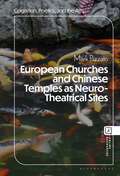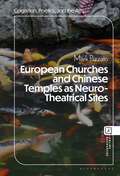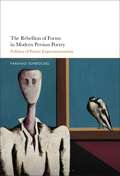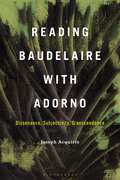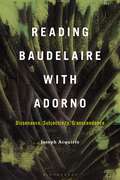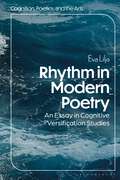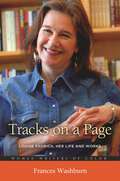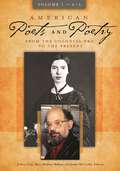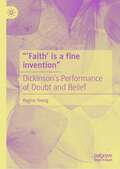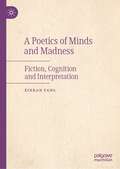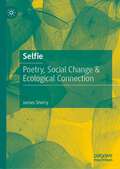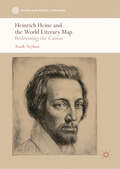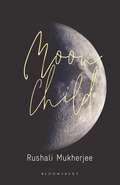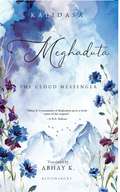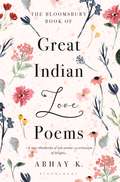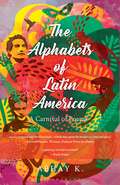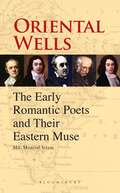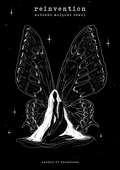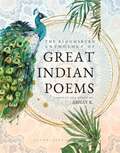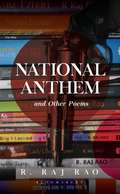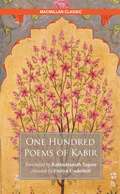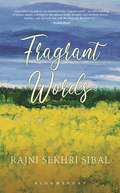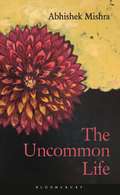- Table View
- List View
European Churches and Chinese Temples as Neuro-Theatrical Sites (Cognition, Poetics, and the Arts)
by Prof. or Dr. Mark PizzatoCompares monumental designs and performance spaces of Christian, Buddhist, and related sanctuaries, exploring how brain networks, animal-human emotions, and cultural ideals are reflected historically and affected today as "inner theatre" elements. Integrating research across the humanities and sciences, this book explores how traditional designs of outer theatrical spaces left cultural imprints for the inner staging of Self and Other consciousness, which each of us performs daily based on how we think others view us. But believers also perform in a cosmic theatre. Ancestral spirits and gods (or God) watch and interact with them in awe-inspiring spaces, grooming affects toward in-group identification and sacrifice, or out-group rivalry and scapegoating. In a study of over 80 buildings – shown by 40 images in the book, plus thousands of photos and videos online – Pizzato demonstrates how they reflect meta-theatrical projections from prior generations. They also affect the embodied, embedded, enacted, and extended (4E) cognition of current visitors, who bring performance frameworks of belief, hope, and doubt to the sacred site. This involves neuro-social, inner/outer theatre networks with patriarchal, maternal, and trickster paradigms. European Churches and Chinese Temples as Neuro-Theatrical Sites investigates performative material cultures, creating dialogs between theatre, philosophy, history, and various (cognitive, affective, social, biological) sciences. It applies them to the architecture of religious buildings: from Catholic, Orthodox, and Protestant in Europe, plus key sites in Jerusalem and prior “pagan” temples, to Buddhist, Daoist, Confucian, and imperial in China. It thus reveals individualist/collectivist, focal/holistic, analytical/dialectical, and melodramatic/tragicomic trajectories, with cathartic poetics for the future.
European Churches and Chinese Temples as Neuro-Theatrical Sites (Cognition, Poetics, and the Arts)
by Prof. or Dr. Mark PizzatoCompares monumental designs and performance spaces of Christian, Buddhist, and related sanctuaries, exploring how brain networks, animal-human emotions, and cultural ideals are reflected historically and affected today as "inner theatre" elements. Integrating research across the humanities and sciences, this book explores how traditional designs of outer theatrical spaces left cultural imprints for the inner staging of Self and Other consciousness, which each of us performs daily based on how we think others view us. But believers also perform in a cosmic theatre. Ancestral spirits and gods (or God) watch and interact with them in awe-inspiring spaces, grooming affects toward in-group identification and sacrifice, or out-group rivalry and scapegoating. In a study of over 80 buildings – shown by 40 images in the book, plus thousands of photos and videos online – Pizzato demonstrates how they reflect meta-theatrical projections from prior generations. They also affect the embodied, embedded, enacted, and extended (4E) cognition of current visitors, who bring performance frameworks of belief, hope, and doubt to the sacred site. This involves neuro-social, inner/outer theatre networks with patriarchal, maternal, and trickster paradigms. European Churches and Chinese Temples as Neuro-Theatrical Sites investigates performative material cultures, creating dialogs between theatre, philosophy, history, and various (cognitive, affective, social, biological) sciences. It applies them to the architecture of religious buildings: from Catholic, Orthodox, and Protestant in Europe, plus key sites in Jerusalem and prior “pagan” temples, to Buddhist, Daoist, Confucian, and imperial in China. It thus reveals individualist/collectivist, focal/holistic, analytical/dialectical, and melodramatic/tragicomic trajectories, with cathartic poetics for the future.
The Rebellion of Forms in Modern Persian Poetry: Politics of Poetic Experimentation
by Dr. Farshad SonboldelAn analysis of the aesthetic, cultural and political aspects of alternative poetic movements and individual poets in three periods: the Constitutional Revolution (1900–1920), the post-constitutional era (1920–1940), and the ascendency of modernism (1940–1960). Farshad Sonboldel shines new light on the history of modern Persian poetry by re-imagining the roles that the aesthetic experimentations of alternative poets played in different phases of the literary revolution in modern Persian poetry. Dominant narratives portray modern Persian poetry as a gradual, rational, and moderate change in the classical regime of aesthetics as well as a response to – and reflection of – cultural and socio-political changes within Iranian society. They also disregard the significance of radical experiments by alternative poets and undervalue the part they played in the initiation and progress of the so-called "literary revolution." These mainstream narratives minimize the socio-political engagement of literary works with the direct reflection of the social reality, and thus neglect the way many alternative poems struggle with socio-political issues through deconstructing the old and constructing new aesthetic systems.Each chapter of The Rebellion of Forms in Modern Persian Poetry is centred around poems chosen for their potential to showcase notable experiments of pioneer movements and individuals in each given period. Examining the formal and thematic aspects of these poems, this book reformulates the story of modern Persian poetry and unravels the relationship between radical aesthetic changes in the practice of poetry and resistance against political and cultural domination in society.
The Rebellion of Forms in Modern Persian Poetry: Politics of Poetic Experimentation
by Dr. Farshad SonboldelAn analysis of the aesthetic, cultural and political aspects of alternative poetic movements and individual poets in three periods: the Constitutional Revolution (1900–1920), the post-constitutional era (1920–1940), and the ascendency of modernism (1940–1960). Farshad Sonboldel shines new light on the history of modern Persian poetry by re-imagining the roles that the aesthetic experimentations of alternative poets played in different phases of the literary revolution in modern Persian poetry. Dominant narratives portray modern Persian poetry as a gradual, rational, and moderate change in the classical regime of aesthetics as well as a response to – and reflection of – cultural and socio-political changes within Iranian society. They also disregard the significance of radical experiments by alternative poets and undervalue the part they played in the initiation and progress of the so-called "literary revolution." These mainstream narratives minimize the socio-political engagement of literary works with the direct reflection of the social reality, and thus neglect the way many alternative poems struggle with socio-political issues through deconstructing the old and constructing new aesthetic systems.Each chapter of The Rebellion of Forms in Modern Persian Poetry is centred around poems chosen for their potential to showcase notable experiments of pioneer movements and individuals in each given period. Examining the formal and thematic aspects of these poems, this book reformulates the story of modern Persian poetry and unravels the relationship between radical aesthetic changes in the practice of poetry and resistance against political and cultural domination in society.
Reading Baudelaire with Adorno: Dissonance, Subjectivity, Transcendence
by Joseph AcquistoReading Baudelaire with Adorno examines Charles Baudelaire's oeuvre – including verse poems, prose poems, and critical writings – in dialogue with the aesthetic theory of Theodor Adorno, for whom the autonomy of the artwork critically resists any attempt to view it merely as a product of its socio-historic context. Joseph Acquisto analyzes Baudelairean duality through the lens of dissonance, arguing that the figure of the subject as a “dissonant chord” provides a gateway to Baudelaire's reconfiguration of subjectivity and objectivity in both esthetic and epistemological terms. He argues that Baudelaire's dissonance depends on older models of subjectivity in order to define itself via the negation of romantic conceptions of a unified lyric subject in favor of one constituted simultaneously as subject and object.This new understanding of subjectivity reconfigures our relationship to the work of art, which will always surpass conceptual attempts to know it fully. Acquisto offers a fresh take on some familiar themes in Baudelaire's work. Dissonant subjectivity in Baudelaire, rather than cancelling esthetic transcendence, points to a different way forward that depends on a new and dialectical relation of subject and object.
Reading Baudelaire with Adorno: Dissonance, Subjectivity, Transcendence
by Joseph AcquistoReading Baudelaire with Adorno examines Charles Baudelaire's oeuvre – including verse poems, prose poems, and critical writings – in dialogue with the aesthetic theory of Theodor Adorno, for whom the autonomy of the artwork critically resists any attempt to view it merely as a product of its socio-historic context. Joseph Acquisto analyzes Baudelairean duality through the lens of dissonance, arguing that the figure of the subject as a “dissonant chord” provides a gateway to Baudelaire's reconfiguration of subjectivity and objectivity in both esthetic and epistemological terms. He argues that Baudelaire's dissonance depends on older models of subjectivity in order to define itself via the negation of romantic conceptions of a unified lyric subject in favor of one constituted simultaneously as subject and object.This new understanding of subjectivity reconfigures our relationship to the work of art, which will always surpass conceptual attempts to know it fully. Acquisto offers a fresh take on some familiar themes in Baudelaire's work. Dissonant subjectivity in Baudelaire, rather than cancelling esthetic transcendence, points to a different way forward that depends on a new and dialectical relation of subject and object.
Rhythm in Modern Poetry: An Essay in Cognitive Versification Studies (Cognition, Poetics, and the Arts)
by Professor Emerit Eva LiljaA pioneering work in cognitive versification studies, scrutinizing the rhythmical means of free verse.Investigating a previously neglected area of study, Rhythm in Modern Poetry establishes a foundation for cognitive versification studies with a focus on the modernist free verse. Following in the tradition of cognitive poetics by Reuven Tsur, Richard Cureton and Derek Attridge, every chapter investigates the rhythms of one modern poem, by Lawrence Ferlinghetti, Sylvia Plath and others, and engages each element in the broader interpretation of the poem in question. In her examination of modernist poetry in English and other Germanic languages, Eva Lilja expands her analysis to discuss both the Ancient Greek and Norse origins of rhythm in free verse and the intermedia intersection, comparing poetic rhythm with rhythm in pictures, sculptures and dance. Rhythm in Modern Poetry thus expands the field of cognitive versification studies while also engaging readers writ large interested in how rhythm works in the aesthetic field.
Tracks on a Page: Louise Erdrich, Her Life and Works (Women Writers of Color)
by Frances WashburnThis book details the intersections between the personal life and exceptional writing of Louise Erdrich, perhaps the most critically and economically successful American Indian author ever.Known for her engrossing explorations of Native American themes, Louise Erdrich has created award-winning novels, poetry, stories, and more for three decades. Tracks on a Page: Louise Erdrich, Her Life and Works examines Erdrich's oeuvre in light of her experiences, her gender, and her heritage as the daughter of a Chippewa mother and German-American father.The book covers Erdrich from her birth to the present, offering fresh information and perspectives based on original research. By interweaving biography and literary analysis, the author, who is herself Native American, gives readers a complete and nuanced understanding of the ways in which Erdrich's identity as a woman and an American Indian have influenced her life and her writing. Tracks on a Page is the first, book-length work to approach Erdrich and her works from a non-Euro-Western perspective. It contextualizes both life and writing through the lenses of American Indian history, politics, economics, and culture, offering readers new and intriguing ways to appreciate this outstanding author.
American Poets and Poetry [2 volumes]: From the Colonial Era to the Present [2 volumes]
by Jeffrey Gray Mary McAleer Balkun James McCorkleThe ethnically diverse scope, broad chronological coverage, and mix of biographical, critical, historical, political, and cultural entries make this the most useful and exciting poetry reference of its kind for students today.American poetry springs up out of all walks of life; its poems are "maternal as well as paternal…stuff'd with the stuff that is coarse and stuff'd with the stuff that is fine," as Walt Whitman wrote, adding "Of every hue and caste am I, of every rank and religion." Written for high school and undergraduate students, this two-volume encyclopedia covers U.S. poetry from the Colonial era to the present, offering full treatments of hundreds of key poets of the American canon. What sets this reference apart is that it also discusses events, movements, schools, and poetic approaches, placing poets in their social, historical, political, cultural, and critical contexts and showing how their works mirror the eras in which they were written. Readers will learn about surrealism, ekphrastic poetry, pastoral elegy, the Black Mountain poets, and "language" poetry. There are long and rich entries on modernism and postmodernism as well as entries related to the formal and technical dimensions of American poetry.Particular attention is paid to women poets and poets from various ethnic groups. Poets such as Amiri Baraka, Nathaniel Mackey, Natasha Trethewey, and Tracy Smith are featured. The encyclopedia also contains entries on a wide selection of Latino and Native American poets and substantial coverage of the avant-garde and experimental movements and provides sidebars that illuminate key points.
“‘Faith’ is a fine invention”: Dickinson’s Performance of Doubt and Belief
by Regina YoongThis book covers nineteenth-century American poet Emily Dickinson who captured the multifaceted nature of life in all of its uncertainties. Studies on her exploration of faith are ample, but in this book, the author uncovers Dickinson’s playful role-play in enacting solemn themes of religion, death, and the unknown. Dickinson’s creativity encompasses not only her use of language but also her poetic personae and self-created poetic stages inviting readers to question, contemplate deeply or even poke fun at life's absurdities. By using performative roles such as the rejected outcast, passive supplicant, and playful warrior, Dickinson unveils--through a paradoxical framework of belief and unbelief-- a line of inquiry that is multifocal and erratic to “tell all the truth and tell it slant.”
A Poetics of Minds and Madness: Fiction, Cognition and Interpretation
by XINRAN YANGThis monograph aims to explore the mind-narrative nexus by conducting a cognitive narratological study on the mad minds in fictional narratives. Set on the interface of narrative and cognitive science (cognitive linguistics, cognitive psychology and cognitive neuropsychology), it adopts an indirect empirical approach to the fictional representation of madness. The American writer Ken Kesey’s novel One Flew Over the Cuckoo’s Nest is chosen as the primary text of investigation, whereas due consideration is also given to other madness narratives when necessary. This book not only demonstrates the value of reading and rereading literary classics in the modern era, but also sheds light on the studies of cognitive narratology, cognitive poetics, madness narratives and literature in general.
Selfie: Poetry, Social Change & Ecological Connection
by James SherrySelfie: Poetry, Social Change & Ecological Connection presents the first general theory that links poetry in environmental thought to poetry as an environment. James Sherry accomplishes this task with a network model of connectivity that scales from the individual to social to environmental practices. Selfie demonstrates how parts of speech, metaphor, and syntax extend bidirectionally from the writer to the world and from the writer inward to identities that promote sustainable practices. Selfie shows how connections in the biosphere scale up from operating within the body, to social structures, to the networks that science has identified for all life. The book urges readers to construct plural identifications rather than essential claims of identity in support of environmental diversity.
Heinrich Heine and the World Literary Map: Redressing the Canon (Canon and World Literature)
by Azade SeyhanThis text provides a key reassessment of the German author Heinrich Heine’s literary status, arguing for his inclusion in the Canon of World Literature. It examines a cross section of Heine’s work in light of this debate, highlighting the elusive and ironic tenor of his many faceted prose works, from his philosophical and political satire to his reassessment of Romantic idealism in Germany and the unique self-reflexivity of his work. It notably focuses on the impact of exile, belonging, exclusion, and censorship in Heine’s work and analyzes his legacy in a world literary context, comparing his poetry and prose with those of major modern writers, such as Pablo Neruda, Nazım Hikmet, or Walter Benjamin, who have all been persecuted and exiled yet used their art as resistance against oppression and silencing. At a time when a premium is placed on the value of world literatures and transnational writing, Heine emerges once again as a writer ahead of his time and of timeless appeal.
Moon Child: A Book of Poems
by Rushali MukherjeeThe book, 'Moon Child' consists of a collection of carefully handpicked poems from the poet's vast collection along with her own hand-drawn sketches.
Kalidasa: Meghduta The Cloud Messenger
by Abhay K.Meghaduta or The Cloud Messenger is a masterpiece of Sanskrit literature, written by Kalidasa some 1500 years ago. This breathtaking poem of 111 stanzas is about a Yaksha, who is banished for a year to central India for neglecting his duties by Kubera-the Lord of Wealth, from his abode at the fabled city of Alaka near Mount Kailasa. The Yaksha exhorts a passing cloud to carry his message across to his beloved in the Himalayas. The cloud is assisted by sylphs, nymphs, eight-legged animals, the wish fulfilling trees, drums, celestial elephants, birds, rare flowers, trees and rivers during his journey.
Bloomsbury Book of Great Indian Love Poems
by Abhay K.From the ancient land of India which has given the world, Kamasutra-a treatise on love, Great Indian Love Poems, selected and edited diligently by master anthologist Abhay K., brings you the fragrant wine of Indian love poetry spread across three millennia, written in multiple languages by gifted poets like -Kalidasa, Mirabai,Bhratrihari, Jayadeva, Silhana, Surdas, Bihari, Muddupalani, Bhavabhuti, Venmaniputti, Vidyapati, Bilhana to just name a few.Sip it slowly, one poem at a time, to savour its richness, to relish its aroma andflavour, depth and finesse. This intoxicating book shows you many facets of love-affectionate, playful, sensuous, erotic, unconditional, pining, aching, among others-leaving you with unforgettable experiences and lasting impressions. A cornucopia of delights, this book is a must read for one and all.
The Alphabets of Latin America: A Carnival of Poems
by Abhay K.The Alphabets of Latin America takes you on a roller coaster ride to one of the most culturally and geographically fascinating continents, known for its legendary Maya and Inca civilizations, sizzling Samba and Tango, the world's biggest carnivals, labyrinths of Borges, magic realism of Gabriel Garcia Marquez, great poetry of Ruben Dario, Pablo Neruda , Gabriela Mistral, Cesare Vallejo, Octavio Paz, fascinating art of Frida Kahlo and Fernando Botero, among others. As you flip its pages, you will find yourself swimming with pink dolphins in the Amazon river, watching the sunset in Martian landscape of Atacama desert, kissing the heights of Machu Picchu and admiring a thousand rainbows at Iguazu Falls. Feliz Viaje!
Oriental Wells: The Early Romantic Poets and Their Eastern Muse
by Md. Monirul IslamOriental Wells explores the manifold ways in which the East was a major source of inspiration for the British Romantic poets, who generously borrowed from the Eastern sources in their effort to reinvent the British poetic tradition. It examines the “orientalization” of Romantic poetry, using works of William Blake, William Wordsworth, Samuel Taylor Coleridge, Robert Southey, and Walter Savage Landor. Analyzing the Romantic poets' multifaceted engagement with the East, the book raises the questions:· What led Blake to formulate his thesis that “All Religions Are One”?· Why do Coleridge's poetry and the play Osorio echo some of the passages from Wilkins' translation of The Bhagvat-Geeta as well as other prominent Eastern religious texts?· What made Southey write his “Hindu epic” The Curse of Kehama and his “Islamic” tale Thalaba, the Destroyer?· What was the exact nature of the negotiations between William Jones' Orientalism and Wordsworth's poetics as formulated in the Preface to Lyrical Ballads, The Prelude, and other poems? The book convincingly argues that the introduction of “cultural goods” from the East played a crucial role in shaping the form and substance of British Romanticism, while acknowledging that the Romantics' reception of the East was tempered by their ideological concerns and religious background.
Reinvention
by Natasha Malpani Oswal2020 has made us all re-examine our relationship with our homes and family. Sometimes, it's easy to leave. But how do you make it work where you are?As the world around us rapidly shifts, Reinvention explores the darker side of growing up. Can we preserve our identity, while building a family? What sacrifices do we have to make for success? Can we have it all- and keep it?Natasha wrote Reinvention after moving back to India after ten years. Her popular first poetry book, Boundless, captured the author's search for her own identity, as she experimented with geographies, and built her career. Here, she tries to reconnect with her roots.Boundless was about finding your voice. Reinvention is about making it heard. The sharpness and honesty of the poems will resonate with you. In a post-pandemic world, change is the only constant.
The Bloomsbury Anthology of Great Indian Poems
by Abhay K.A unique initiative of poet-diplomat Abhay K., The Bloomsbury Anthology of Great Indian Poems, offers a treasury of poems, selected from over 3000 years of Indian poetry in 28 languages. It brings forth the richness and diversity of poetry that exist in India's myriad languages and dialects. There is an abundance of light, irony, sensuousness and spirituality in these poems, which delight our senses invoking distinct tastes, smells, colours and moods of India.
National Anthem and Other Poems
by R Raj Rao'A poetry of open sensuality with no holds barred is what characterizes the work of R Raj Rao. As in his previous volumes, Rao explores the homosexual world with a sense of droll humour, biting irony and startling frankness, a scatology tempered by form and structure. From 'Gay Hind' to 'gay abandon', from encounters in local trains to a visit to a ribald Rio de Janeiro, the poet extends the frontiers of gay literature in India. An extra bonus is a series of deftly written poems set off by his admiration for and his eventual meeting with his namesake, the novelist Raja Rao in Austin in the US.'-Manohar Shetty
Oriental Wells: The Early Romantic Poets and Their Eastern Muse
by Md. Monirul IslamOriental Wells explores the manifold ways in which the East was a major source of inspiration for the British Romantic poets, who generously borrowed from the Eastern sources in their effort to reinvent the British poetic tradition. It examines the “orientalization” of Romantic poetry, using works of William Blake, William Wordsworth, Samuel Taylor Coleridge, Robert Southey, and Walter Savage Landor. Analyzing the Romantic poets' multifaceted engagement with the East, the book raises the questions:· What led Blake to formulate his thesis that “All Religions Are One”?· Why do Coleridge's poetry and the play Osorio echo some of the passages from Wilkins' translation of The Bhagvat-Geeta as well as other prominent Eastern religious texts?· What made Southey write his “Hindu epic” The Curse of Kehama and his “Islamic” tale Thalaba, the Destroyer?· What was the exact nature of the negotiations between William Jones' Orientalism and Wordsworth's poetics as formulated in the Preface to Lyrical Ballads, The Prelude, and other poems? The book convincingly argues that the introduction of “cultural goods” from the East played a crucial role in shaping the form and substance of British Romanticism, while acknowledging that the Romantics' reception of the East was tempered by their ideological concerns and religious background.
One Hundred Poems of Kabir
by KabirKabir is one of the most beloved Indian mystics. He is also amongst the pioneers of the Bhakti Movement in North India. One Hundred Poems of Kabir is a classic book of poems, translated into English by the maestro, Rabindranath Tagore. These poems are songs of love written in the voice of a lover longing for the beloved. The mystical connotations unravel the journey of the soul to its union with the Supreme Being.
Fragrant Words
by Rajni Sekhri SibalFragrant Words is a lyrical illustration of life from the poet's perspective. It is a medley of verses: some soft and gentle, others heady and strong, while still others evoke the aroma of a memory long forgotten… Like the vivid strokes of a painter the anthology displays the various colours on a poet's palette – the black, the white and the mesmerizing hues and shades in between. A little like life…
Uncommon Life
by Abhishek MishraThe Uncommon Life is a magnificent cry to all to rise and break the shackles of lethargy, corruption, poverty and lies that bind us to a mediocre life. It calls on one to recognize their true self for what it is-a pure thing that craves love, peace, harmony and joy. Political and social angst, the enduring love for the family and country and the sadness and joy of life are expressed beautifully and vividly in this slim volume of poems. Each poem, in a unique way, brings catharsis and healing while taking the reader on a journey to the outer landscape of nature and one's soul. The poet appeals for a life that is beyond the mundane. His love for his motherland and his family permeate every thought he expresses. His anguish knows no bounds when he sees how poverty has maimed the souls of good people and how apathy and corruption have led to a moral and ethical rot. He calls out for truth in our action, deeds and thoughts.Words and rhyme flow lyrically and unabashedly as we embark on a journey of the human condition, through lands, arcane, pristine and jaded. A traveller, a thinker and a weaver of words, Abhishek Mishra wistfully tell us how nothing changes and yet nothing remains the same.
